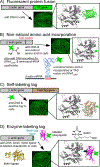A Critical and Comparative Review of Fluorescent Tools for Live-Cell Imaging
- PMID: 27860833
- PMCID: PMC12034319
- DOI: 10.1146/annurev-physiol-022516-034055
A Critical and Comparative Review of Fluorescent Tools for Live-Cell Imaging
Abstract
Fluorescent tools have revolutionized our ability to probe biological dynamics, particularly at the cellular level. Fluorescent sensors have been developed on several platforms, utilizing either small-molecule dyes or fluorescent proteins, to monitor proteins, RNA, DNA, small molecules, and even cellular properties, such as pH and membrane potential. We briefly summarize the impressive history of tool development for these various applications and then discuss the most recent noteworthy developments in more detail. Particular emphasis is placed on tools suitable for single-cell analysis and especially live-cell imaging applications. Finally, we discuss prominent areas of need in future fluorescent tool development-specifically, advancing our capability to analyze and integrate the plethora of high-content data generated by fluorescence imaging.
Keywords: cellular dynamics; fluorescent dyes; fluorescent proteins; live-cell imaging; probes.
Figures


References
-
- Spence MTZ, Johnson ID. 2010. Molecular Probes Handbook: A Guide to Fluorescent Probes and Labeling Technologies. Carlsbad, CA: Life Tech. Corp. 11th ed.
-
- Wysocki LM, Lavis LD. 2011. Advances in the chemistry of small molecule fluorescent probes. Curr. Opin. Chem. Biol. 15(6):752–59 - PubMed
Publication types
MeSH terms
Substances
Grants and funding
LinkOut - more resources
Full Text Sources
Other Literature Sources

